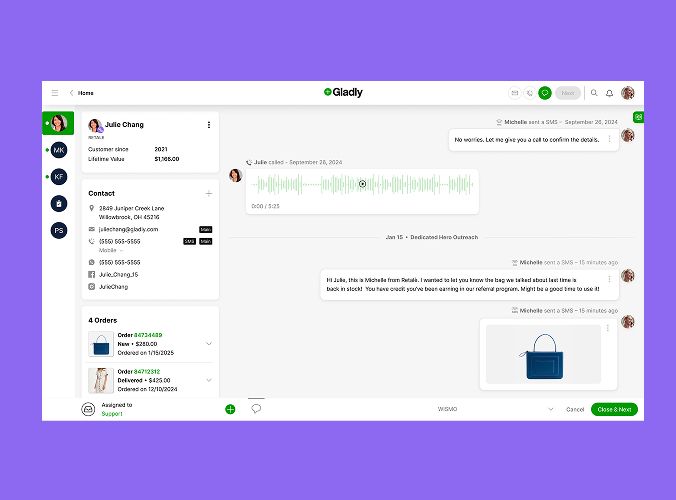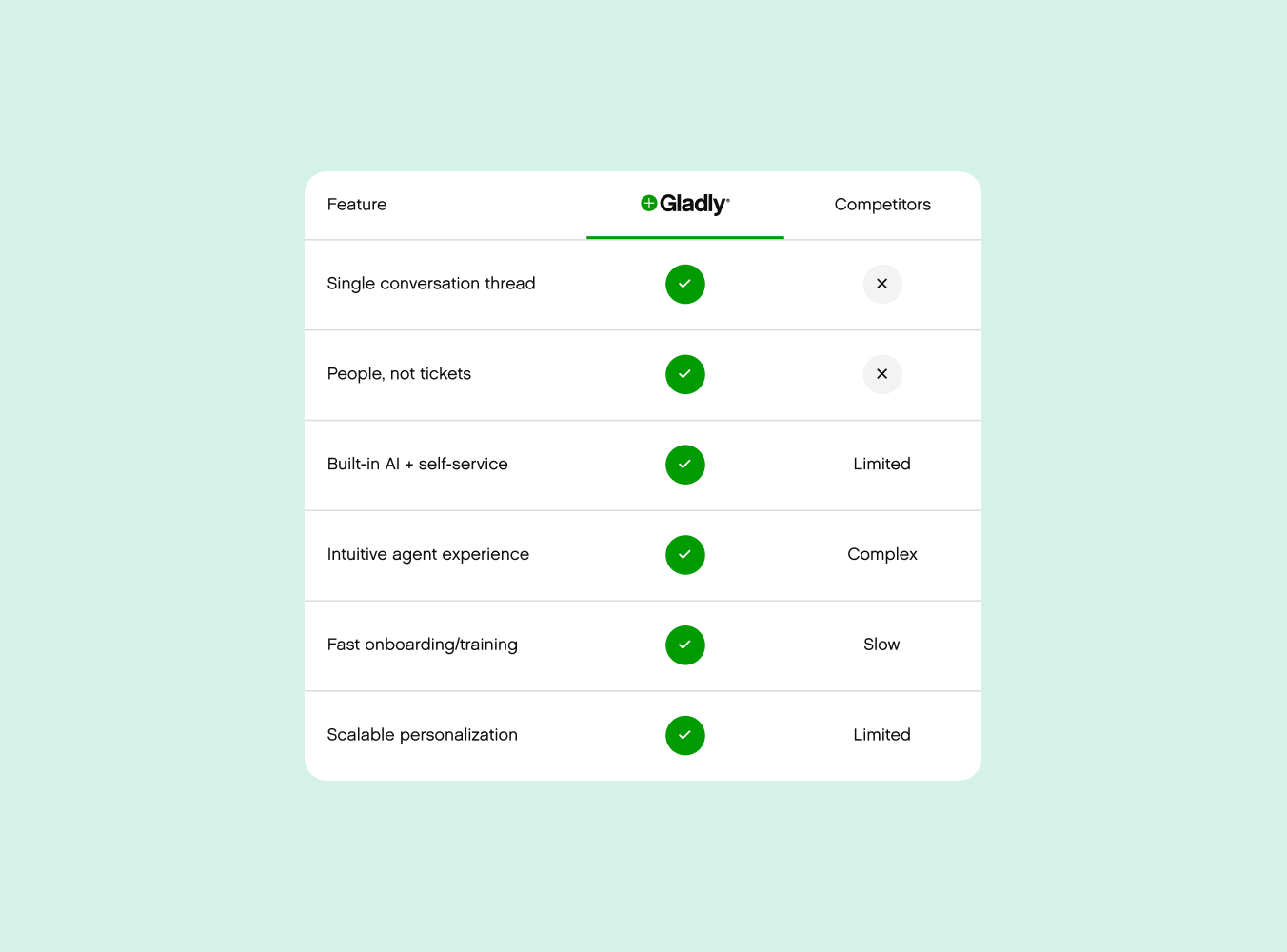November 18, 2025
Static vs. dynamic. When recommendation widgets wait for clicks, AI sales agents start conversations.
Every e-commerce director knows the feeling. You install a product recommendation widget, watch the analytics for a week, and see...something. Maybe a tiny lift in average order value. Maybe nothing at all. The widget sits there, waiting. It shows products when customers scroll. It suggests add-ons at checkout. But it never starts anything.
Compare that to what happens when you bring in AI agents. For example, a customer lands on a moisturizer page owned by a mid-size beauty company. They hesitate for 38 seconds, then begin to leave. An AI agent opens a chat: "Shopping for dry skin or anti-aging?" The customer answers. Three messages later, they buy the moisturizer, a matching serum, and have signed up for auto-replenishment.
Order value: $127. Without the agent? Probably zero.
The difference isn't just technology. It's architecture. Static recommendation widgets are built on workflows of if/then logic that waits for you to click. AI sales agents are built on agency. Systems that decide when to speak, what to say, and how to adapt.
One architecture waits for signals. The other creates them.
The passive web vs. the active store
Walk into a Nordstrom and a salesperson approaches you. Not immediately. Good salespeople read the room. But within 90 seconds, someone will ask if you need help. Online? Most brands still operate like a warehouse with helpful signage.
Recommendation widgets are signage. They point. "You might also like (this)." "Customers who bought this also bought (this)." They're useful the same way aisle markers are useful. But they don't sell.
Here's why that matters now. The average e-commerce conversion rate in 2024 dropped to 1.65%, down from 1.97% in 2023. Acquisition costs rose 5.3%. Traffic is expensive. Browsers are impatient. Waiting for them to click your carefully A/B tested widget isn't a strategy, it's blind hope.
The active store sends someone over. Not a pushy bot that interrupts every visitor, but an intelligent agent that watches behavior and intervenes at the right moment.
What changes when you start the conversation
Proactive engagement sounds obvious until you think about what it actually requires. A recommendation widget needs two things. Data about what was purchased together, and a place to show the results. An AI sales agent needs to understand context, generate relevant questions, and maintain state across a conversation.
According to an analysis of 17 million shopping sessions, shoppers who engage with AI chat during their visit complete purchases 47% faster than those who don't. Returning customers who use conversational tools spend 25% more than those who browse alone. That's not a widget effect. That's a salesperson effect.
Here's what changes:
Cart recovery becomes conversation. Instead of sending an email 24 hours later with a discount code, the agent notices abandonment in real time. "Still deciding between the king and queen size?" One question can save a $400 mattress sale.
Product discovery stops relying on search. A customer types "something for my lower back." A widget returns products tagged "back pain." An agent asks three questions: sitting pain or standing pain, sharp or dull, worse in morning or evening. And then it narrows 200 SKUs to the right orthopedic pillow and lumbar support combo.
Upsells happen naturally. Widgets show "frequently bought together" bundles. Agents say, “Running shoes work great alone, but pairing them with supportive insoles reduces knee pain for many runners. Want to add them? One sounds like an algorithm. The other sounds like a human employee who actually knows sports.
Architecture: static workflows vs. dynamic agents
Agentic AI, AI that acts with autonomy to achieve goals, makes decisions in real time based on context. It's not running a predetermined script. It observes what the customer does, evaluates multiple possible actions, and chooses the one most likely to help. If the customer asks about return policies, the agent doesn't just link to a FAQ. It reads current inventory levels, sees the customer previously returned two items, and offers to hold the product for in-store pickup instead.
This architectural shift changes everything downstream.
Pricing is a product strategy
Here's where it gets interesting. How you pay for technology reveals what it's built to do.
Recommendation widgets charge per seat or per month because they're infrastructure. You install them. They run. Your growth is your problem. The widget doesn't care if you sell more.
AI agents increasingly use outcome-based pricing, where you pay based on results, not usage. Outcome-based pricing means the vendor only gets paid when the tool drives a sale, upsell, or other measurable business outcome. If the agent handles a thousand chats but generates zero revenue, you pay zero.
Why would a vendor accept that risk? Because they believe their agent actually works. And because when it works, the economics are better for both sides than a flat fee.
The hybrid pricing model is emerging as the standard: a low monthly base (often $500-2,000) plus a percentage of attributed revenue (typically 3-8%). The base covers infrastructure. The performance fee aligns incentives. If the agent drives an extra $100K in monthly sales, you pay $3K-8K. That's a 12-to-1 ROI at the low end.
Compare that to a recommendation widget at $400/month that lifts revenue $6K. Same 15-to-1 ROI, but the absolute numbers matter. When you're adding six figures in monthly revenue, paying $8K feels like a bargain. When you're adding $6K, paying $400 feels like overhead.
Pricing models shape behavior.
Flat fees encourage "set it and forget it." Outcome-based pricing forces vendors to keep improving the agent, because if performance drops, so does their revenue. That's why the best AI agent platforms now include weekly performance reviews, proactive optimization, and shared KPI targets.
How to evaluate agents vs. widgets
Ask these questions:
Can it handle complexity? Widgets show products. Agents compare 13” vs 14” laptops, explain CPU tradeoffs, and justify a $200 add-on in real language.
Does it reduce support burden? If the agent handles fit questions, return policy, and shipping timelines, you're not just driving sales—you're cutting support costs. One DTC apparel brand saw chat support tickets drop 40% after deploying an agent that answered pre-purchase questions.
Will it scale with you? Widgets need reconfiguration when you launch new categories. Agents train on new product data and keep working.
What does failure cost? A buggy widget shows wrong products. Annoying. A buggy agent gives bad advice and kills trust. Catastrophic. Make sure your vendor has guardrails, monitoring, and fast rollback.
The human layer: trust, taste, and timing
Technology doesn't sell furniture. People sell furniture. Even when the person is code.
The best AI agents sound like your best salesperson. They know when to ask questions and when to give space. They mirror tone—playful with a 24-year-old buying throw pillows, professional with a 55-year-old buying an executive desk. They remember: "Last time you mentioned your bedroom is low-light. This duvet color works better in dim spaces."
That's taste. And taste is still a human advantage. You can train an AI on your brand guidelines, product knowledge, and customer service principles, but the retailers winning with agents are the ones who treat them like employees, not software. They onboard them. They review transcripts. They give feedback.
One trick: have your best salesperson (or customer service lead) write sample conversations for common scenarios. Not scripts, but real conversations. "The customer is worried the coffee table is too small for their sectional." "The customer wants a desk but lives in a studio apartment." "The customer returned the last two pillows we sent because they were too firm."
Use those as training data. The agent learns not just what to say, but how your brand talks.
Timing matters, too. Intervening too early feels pushy. Too late and the customer's gone. The pattern most agents follow: watch for 20-40 seconds of engaged behavior (scrolling, zooming images, viewing related products), then open with a question, not a pitch. "Shopping for yourself or a gift?" beats "Can I help you?" because it's specific and implies you've been paying attention.
It’s time to change sides
Recommendation widgets won the last decade because they were better than nothing. They brought some personalization to an impersonal web. But the web isn't impersonal anymore. It's conversational.
The shift from static to dynamic isn't about technology trends. It's about customer expectations. Shoppers who return to a site and use AI chat spend 25% more because they get help in the moment they need it. They don't have to dig through FAQs or wait for email support. They ask. The agent answers. The sale happens.
Widgets were built for an era when e-commerce meant replicating catalog shopping online. Agents are built for an era when e-commerce means replicating the best parts of in-store shopping. The human connection, the expert guidance, the feeling that someone's actually helping, without the overhead of human labor.
The math is clear. The architecture is proven. The pricing models align incentives. What's stopping most brands isn't technology. It's the same thing that always stops adoption: the belief that what worked before will keep working.
Static tools had their decade. The dynamic era is here. The only question is whether you'll be early or too late.
Want an agent that actually sells? See Gladly in action.
Frequently Asked Questions
Recommended reading

Why agentic AI is the next big thing
Discover agentic AI: customer service that acts! Explore how agentic AI automates complex tasks, empowers CX teams, and delivers personalized experiences.
By
Angie Tran

Omnichannel AI for CX teams
Deliver fast, connected service across voice, chat, email, SMS, and social with one AI agent built for real conversations.

See how Gladly compares
Discover how Gladly stacks up against Zendesk, Salesforce, Genesys, Freshdesk, Kustomer, Gorgias, Sierra, and Decagon.
